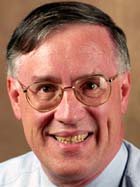Night. A time normally associated with ballgames, social gatherings and sometimes even sleep.
But University College in Arts & Sciences has been offering people a different evening routine for 75 years.
While students first took evening classes at the University in 1854, it wasn’t until 1931 that the night school became “University College.” The name is derived from the urban adult-education centers founded in the 19th century by Oxford and Cambridge universities in England.

Since that first evening program, offering “mental and written Arithmetic, Algebra, Reading, Grammar, Declamations, and if desirable, writing and spelling,” the college has become one of the most popular — and influential — adult higher-education programs around.
“For 75 years, University College has represented the best in adult part-time and continuing education in the St. Louis area,” said University College Dean Robert E. Wiltenburg, Ph.D., “for excellence in teaching and learning, innovation and experiment, and accessibility.”
The first Washington University classes were evening classes, and the first students were part-time students. Classes at the newly chartered Washington University began October 22, 1854, in what was named the O’Fallon Evening School.
Ninety students enrolled that first evening. By February 1855, the program had 270 students, all males, ranging in age from 8 to 46. Most were semiskilled workers or laborers, and 60 percent were immigrants, mostly from Germany, Ireland and England.
By 1923, the Extension Division had 2,400 students — more than the number of full-time students. A reorganization created University College in February 1931 and granted it the power to confer baccalaureate degrees and enroll students in full-time programs of study.
Dramatic growth followed.
“At various points in its history — notably during the 1930s when few could afford to study full-time, and after World War II when many needed to combine work, family and education — University College has had more students than any other division of the University,” Wiltenburg said.
In the early 1930s, University College was the busiest school on campus, with 2,130 students in 1933.
Under both Dean Frederick W. Shipley and his successor and fellow classics professor Frank Debatin, it offered innovative courses such as Chinese and Russian, and degree-granting programs. These included B.S. degrees in journalism and in education beginning in 1932; an arrangement with the School of Fine Arts, which did not offer its own degrees until 1941, to give bachelor’s degrees to prospective art teachers; and a master’s degree in education starting in 1936.
Military veterans helped raise enrollment to 8,000 in 1948-49. Innovative noncredit courses, popular lecture programs, film series and conferences established in the 1950s made University College the community leader in adult education, and in 1957-58, enrollment approached 10,000.
In the academic year 1972-73, University College counted more than 17,000 course enrollments.
After a reorganization that incorporated University College into Arts & Sciences in 1980, the Master of Liberal Arts Program, the only one of its kind in St. Louis, got its start under the leadership of Robert C. Williams, then the dean of University College and professor of history in Arts & Sciences.
Students took part in interdisciplinary seminars organized into four categories: ideas and inquiry; the creative imagination; science and human values; and historical understanding.
Today, through University College in Arts & Sciences, part-time, evening and summer students may earn baccalaureate and master’s degrees and certificates, or attend classes for personal enrichment, at a world-class academic institution.
Noncredit options at University College include special audit and short courses and the Lifelong Learning Institute.
And U. College shows no signs of slowing down, hoping for at least another 75 years of unqualified success.
“We are currently the largest we’ve been in the past 25 years, with about 1,500 adult students (one-third of them WUSTL employees) and 3,300 enrollments in about 250 courses,” Wiltenburg said. “And our Lifelong Learning Institute has nearly 600 participants.”